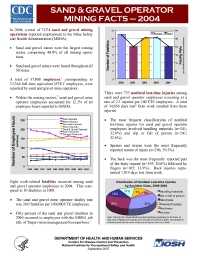Mining Publication: Sand and Gravel Operator Mining Facts - 2004
Original creation date: September 2007
In 2004, a total of 7,074 sand and gravel mining operations reported employment to the Mine Safety and Health Administration (MSHA). Sand and gravel mines were the largest mining sector, comprising 48.9% of all mining operations. Sand and gravel mines were found throughout all 50 states. A total of 37,000 employees, corresponding to 33,364 full-time equivalent (FTE) employees, were reported by sand and gravel mine operators. Within the mining sectors, sand and gravel mine operator employees accounted for 12.3% of all employee hours reported to MSHA. Eight work-related fatalities occurred among sand and gravel operator employees in 2004. This compared to 10 fatalities in 2003. The sand and gravel mine operator fatality rate was 24.0 fatalities per 100,000 FTE employees. Fifty percent of the sand and gravel fatalities in 2004 occurred to employees with the MSHA job title of 'Supervision/management/foreman/boss.' There were 753 nonfatal lost-time injuries among sand and gravel operator employees occurring at a rate of 2.3 injuries per 100 FTE employees. A total of 34,856 days lost from work resulted from these injuries. The most frequent classifications of nonfatal lost-time injuries for sand and gravel operator employees involved handling materials (n=241; 32.0%) and slip or fall of person (n=241; 32.0%). Sprains and strains were the most frequently reported nature of injury (n=296; 39.3%). The back was the most frequently reported part of the body injured (n=155; 20.6%) followed by fingers (n=105; 13.9%). Back injuries represented 7,919 days lost from work. In 2004, 20 cases of occupational illnesses were reported to MSHA by sand and gravel operators. This compares to 15 cases reported in 2003. Joint, tendon, or muscle inflammation or irritation accounted for the most frequently reported occupational illnesses (n=10; 50.0%). There were six cases of hearing loss or impairment reported to MSHA (30.0% of all occupational illnesses reported). Other cases of occupational illness reported by sand and gravel mining operations in 2004 included heat stroke, sunstroke, heat cramps, etc. (n=2; 10.0%) and dermatitis (n=2; 10.0%).
Authors: National Institute for Occupational Safety and Health
Brochure/flyer - September 2007
NIOSHTIC2 Number: 20032739
Pittsburgh, PA: U.S. Department of Health and Human Services, Public Health Service, Centers for Disease Control and Prevention, National Institute for Occupational Safety and Health, DHHS (NIOSH) Publication No. 2007-171, 2007 Sep; :1-2
See Also
- Coal Operator Mining Facts - 2005
- Metal Operator Mining Facts - 2002
- Metal Operator Mining Facts - 2004
- Metal Operator Mining Facts - 2005
- Noncoal Contractor Mining Facts - 2003
- Nonmetal Operator Mining Facts - 2002
- Nonmetal Operator Mining Facts - 2008
- Sand and Gravel Operator Mining Facts - 2006
- Stone Operator Mining Facts - 2003
- Stone Operator Mining Facts - 2005
- Page last reviewed: 9/21/2012
- Page last updated: 9/21/2012
- Content source: National Institute for Occupational Safety and Health, Mining Program


 ShareCompartir
ShareCompartir
